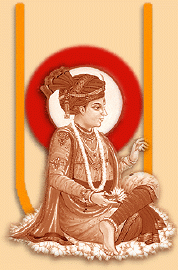Gurus & Saints of India
Bhagwan Swaminarayan

Sahajanand Swami (April 2, 1781 - June 1, 1830) or Bhagwan Swaminarayan is the central figure in a modern form of Hinduism known as the Swaminarayan Faith and is the founder of the Swaminarayan Sampraday in which followers offer devotion to Bhagwan Swaminarayan as the final manifestation of god. In this particular tradition, Sahajanand Swami is respectfully addressed as Bhagwan Swaminarayan by his followers.
Sahajanand Swami was born in Chhapaiya, Uttar Pradesh (Northern India). He settled in the West Indian state of Gujarat, where he then preached his doctrine until his death in 1830. Sahajanand Swami is also known as Lord Swaminarayan, Ghanshyam Pande, Ghanshyam Maharaj, Shreeji Maharaj, and Shri Hari.
Childhood
Swaminarayan was born outside of Gujarat in Chhapaiya, Uttar Pradesh, a small village near Ayodhya, in the Hindi-speaking area of present-day Uttar Pradesh. He was named Ghanshyam Pande by his parents, Hariprasad Pande (father, also known as Dharmadev) and Premvati (mother, also known as Bhaktimata) of the Brahmin caste of Sarvariya. He had two brothers, Rampratapji Pande, his older brother, and Icharamji Pande, his younger brother.In the liturgy of the sect, the story of the announcement of the coming birth of Krishna in the Bhagavata Purana is repeated in the story of the birth of Swaminarayan, and merging of the images and stories of Swaminarayan and Krishna has occurred. In Vaishnava mythology Uddhava, who is considered to be the chief disciple of Krishna, was ordained to spread his message in a future birth, and some groups of Swaminarayan Faith believe that he reappeared as Ramananda Swami to prepare the way for another manifestation of Krishna. He was born on the occasion of Ram Navmi, hence Chaitra Sud Nom of the Vikram Samvat calendar is celebrated as both Rama Navami as well as Swaminarayan Jayanti by his followers. This celebration marks the beginning of the ritual calendar for his follower - starting with of the birthday of Swaminarayan on the ninth day of the bright half of the month of Chaitra in the Indian calendar (March-April).
Travels
Nilkanth Varni during his travelsAfter the death of both of his parents,
Ghanshyam Pande left his home at age 11 on June 29, 1792. He took the name
Nilkanth Varni while on his journey. Nilkanth Varni traveled across India in
search of an ashram or sampradaya that practiced what he considered a
correct understanding of Vedanta, Samkhya, Yoga, and Pancaratra (the four
primary schools of Hinduism).To find an ashram that correctly practiced the
meaning of these four primary schools of Hinduism, he asked the following
five questions on the basic Vaishnava Vedanta categories:
What is jīva?
What is Īśvara?
What is Maya?
What is Brahman?
What is Parā brahman?
In the year 1799, Nilkanth's journey as a yogi eventually concluded in Loj,
Gujarat, where Muktanand Swami, who was a senior disciple of Ramanand Swami
and was twenty-two years older than Nilkanth himself, answered the five
questions satisfactorily. He decided to stay to get an opportunity to meet
and become a disciple of Ramanand Swami.
Leadership as Sahajanand Swami
Nilkanth's understanding of the metaphysical and epistemological concepts of the Pancha-Tattvas (five eternal entities as outlined above) combined with the level of his mental and physical discipline are said to have inspired even the senior sadhus of Ramanand Swami.
Nilkanth Varni received sannyasa initiation and with this initiation he received the name Sahajanand Swami to signify his new status.
At the age of 21, he was given the headship of the sect known as Uddhav Sampraday (Later known as Swaminarayan Sampraday) with the blessings of his guru Ramanand Swami, who handed over the reins of the Religious diocese to him and died.
Mantra
Sahajanand Swami was later known as Swaminarayan after the mantra he taught, at a sabha, gathering, in Faneni a fortnight after the passing away of Ramanand Swami. A name given to him by Ramananda was Narayan Muni, but from this time the name takes on special meaning, and he is called Swaminarayan. He is said to have intimated that he was a manifestation of Krishna in a meeting with the Reginald Heber (who was then the Lord Bishop of Calcutta) in the year 1825. He gave his followers a new mantra to repeat in their rituals: Swaminarayan. As early as AD 1804 Sahajanand Swami was described as a manifestation of god, in the first work written by a disciple, Nishkulananda Swami, in the year AD 1804. This work is called the Yama Danda and is a of a great historical value because it is the first work written in the sect